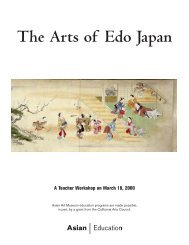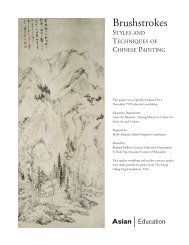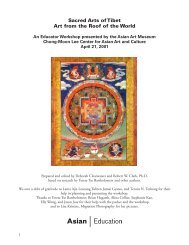Download PDF (free) - Asian Art Museum | Education
Download PDF (free) - Asian Art Museum | Education
Download PDF (free) - Asian Art Museum | Education
Create successful ePaper yourself
Turn your PDF publications into a flip-book with our unique Google optimized e-Paper software.
In this market-driven art form, styles often changed. The earliest prints were black<br />
and white, hand coloring being gradually adopted later. As coloring by hand was too<br />
time consuming to produce prints in enough quantity to satisfy the public’s growing<br />
demand, techniques were developed to block print simple two- or three-color images.<br />
By 1765, artists like Harunobu were designing polychrome prints called nishiki-e or<br />
“brocade pictures.” The addition of more colors resulted in prints that were more<br />
realistic and expressive. Pigments for these prints were water based, vegetable dyes,<br />
which produced a soft and subtle range of colors. <strong>Art</strong>ists and printers collaborated<br />
to produce ever more subtle effects such as the color nuances of a reflection in water<br />
and mirrors, or seeing objects through gauze textiles. A metallic powder called<br />
mica was sometimes added to colors to give a shimmering surface. By the time of<br />
Hokusai and Hiroshige, ukiyo-e prints were produced with up to twenty different<br />
colors, virtually each requiring its own carved block. <strong>Art</strong>ists were constantly trying<br />
to outdo one another in their prints, not only with beautiful colors, but also clever<br />
compositions.<br />
Major Themes in Ukiyo-e Prints<br />
Courtesans and Actors<br />
Beautiful women of the Yoshiwara were among the original ukiyo-e subjects. These<br />
prints were the most popular and served as pin-ups, similar to posters of movie stars<br />
and celebrities today. Such overtly commercial products were considered cheap and<br />
vulgar by the nobility, although the cultured and beautiful courtesan represented the<br />
romanticized, feminine ideal among the commoners.<br />
In addition to bijin, popular Kabuki actors achieved immortality through<br />
ukiyo-e prints. Actors (like prostitutes) were excluded from the official social<br />
hierarchy. Nevertheless, they were treated as movie stars of the day, and were<br />
depicted in prints to announce an upcoming show or celebrate a certain performance.<br />
Such prints showed actors as the characters they played, as well as in behind-thescenes<br />
preparations for their plays.<br />
Landscapes<br />
Landscapes, a minor genre since the early period of ukiyo-e, began to appear as an<br />
independent subject in prints during the late 1820s for various reasons. In 1800,<br />
aiming at reducing the influence of the merchant class, the government issued<br />
measures to limit the production of Kabuki prints. They also restricted the use of<br />
colors in prints, and banned the use of expensive mica to create a shiny background<br />
in portraits of courtesans and actors. These restrictions, coupled with improved<br />
printing techniques that allowed for superior gradations of color and subtle<br />
expressions in sky, light, water, and snow, resulted in the rise of landscape prints.<br />
With increased travel during the Edo period, landscape ukiyo-e also served as<br />
personal mementos and intimate souvenirs of places people had already seen or<br />
would someday visit. Hokusai and Hiroshige are primarily known as landscape<br />
artists who brought this genre to its highpoint during the 1830s.<br />
<strong>Asian</strong> <strong>Art</strong> <strong>Museum</strong><br />
8<br />
<strong>Education</strong> Department
















